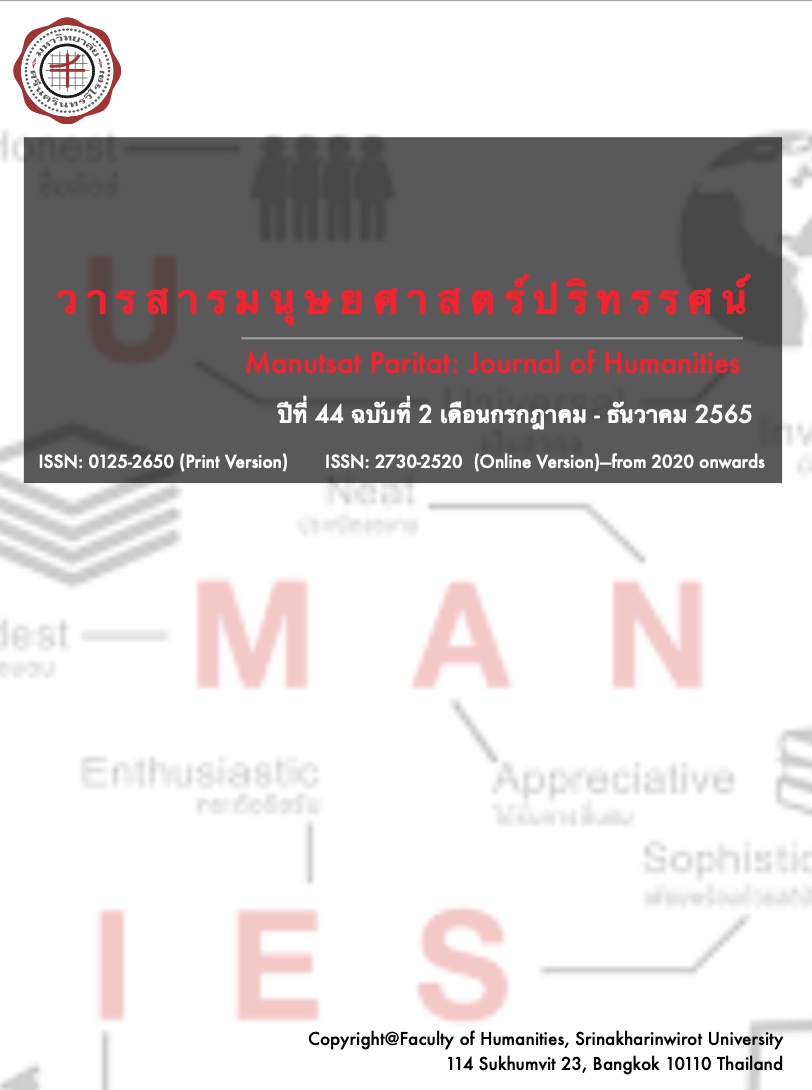Gothic, Gender, and Power in Charlotte Brontë’s Villette
Main Article Content
Abstract
This article focuses on gender power dynamics in relation to Gothic elements found in Charlotte Brontë’s Villette. The intricate and shifting dynamic relationship of Gothic elements, gender, and power in Villette underlie what might be seen as sexual oppression. According to Craig (2012), different perspectives on Victorian culture which found in Gothic novels could reflect some cultures of oppression, such as the image of women as the inferior sex. Some people might see Gothic literature as depicting women’s oppression in a patriarchal society. However, this article sees it as a productive way of deconstructing gender power structure on the intersections of Gothic elements, gender, and power.
Article Details

This work is licensed under a Creative Commons Attribution-NonCommercial-NoDerivatives 4.0 International License.
Any unauthorized copying, publication, reproduction or distribution of copyrighted works appeared in Manutsat Paritat: Journal of Humanities is an infringement of the copyright owners’ rights. To authorize the copying, publication, reproduction or distribution of copyrighted works to be appeared in other printed materials or any online media, please write to MPJHthaijo@gmail.com for permission.
References
Bailim, M. (1944). The sickroom in Victorian fiction: The art of being ill. Cambridge: Cambridge University Press.
Bloch, R. H. (1991). Medieval misogyny and the invention of western romantic love. Chicago: U of Chicago Press.
Botting, F. (1996). Gothic (The new critical idiom). London: Routledge.
Brontë, C. (2012) Villette. London: The Penguin English Library.
Butler, J. (1993). Bodies that matters: On the discursive limits of “sex”. New York: Routledge.
Butler, J. (1999). Gender trouble: Feminism and the subversion of identity (2nd ed.) New York: Routledge.
Cambridge dictionary. (2012). Cambridge University Press. https://dictionary.cambridge.org/
Craig, S. F. (2012). Ghosts of the mind: The supernatural and madness in Victorian Gothic literature. (Honors Thesis). The Aquila Digital Community: University of Southern Mississippi.
Davis, M. A. (2012). Useful dangers: The erotics of form, Sadomasochism, Victorian narrative. (Doctoral Thesis). University of Southern California. ProQuest Dissertations Publishing.
Derrida, J. (1967). De la grammatologie. Paris: Les Éditions de minuit.
Ellis, K. F. (2012). Can you forgive her? The Gothic heroine and her critics. A new companion to the Gothic. (Ed.) David Punter. Hoboken: Wiley.
Finley, A. (2018). Female power and the supernatural in early Gothic literature. (UCLA Departmental Honors Thesis).
Fletcher, R. P. (2003). “Convent thoughts”: Augusta Webster and the body politics of the Victorian cloister. Victorian Literature and Culture, 31(1): 295-313.
Flotte, K. (2015). Cognitive castles: Place and the Castle of Otranto. University of New Orleans Thesis and Dissertation.
Forsyth, B. (1997). The two faces of Lucy Snowe: A study in deviant behavior. Studies in the Novel, 29(1): 17-25.
Hause, M. (2010). The figure of the nun and the Gothic construction of femininity in Matthew Lewis’s The Monk, Ann Radcliffe’s The Italian, and Charlotte Brontë’s Villette. (Masters Thesis). JMU Scholarly Commons. James Madison University. http://commons.lib.jmu.edu/master201019/390.
Heilman, R. B. (1958). Charlotte Brontë’s ‘new’ Gothic. From Jane Austen to Joseph Conrad: Notes collected in memory of James T. Hillhouse. (Eds.) Robert C. Rathbun and Martin Steinmann, Jr. St Paul: U of Minnesota.
Hoeveler, D. L. (1998). Gothic feminism: The professionalization of Gender from Charlotte Smith to the Brontës. University Park, Pa.: Pennsylvania State University Press.
Kaplan, D. (1983). Proper ladies and heroines. NOVEL: A Forum on Fiction, 17(1): 83.
Keech, J. M. (1974). The survival of the Gothic response. Studies in the Novel, 6(2): 130-144.
Kim, Jim-O. (2003). Charlotte Brontë and female desire. New York: Peter Lang Publishing.
Massé, M. A. (1992). In the name of love: Women, Masochism, and the Gothic. Ithaca: Cornell University Press.
Mitchell, J. (1994). The stone and the scorpion: The female subject of desire in the novel of Charlotte Brontë, George Eliot, and Thomas Hardy. Westport, Connecticut: Greenwood Press.
Mullan, J. (2014). “The origin of the Gothic.” Discovering literature: Romantics & Victorians. British Library. https://www.bl.uk/romantics-and-victorians/articles/the-origins-of-the-gothic
Nichols, N. (1983). Place and eros in Radcliffe, Lewis, and Brontë. The female Gothic. (Ed.) Juliann Fleenor. Montreal: Eden Press.
Paz, D. G. (1992). Popular anti-Catholicism in mid-Victorian England. Stanford UP.
Sadoff, D. F. (1982). Monsters of affection: Dickens, Eliot and Brontë on fatherhood. Baltimore: Johns Hopkins University Press.
Sedgwick, E. K. (1986). The coherence of Gothic conventions. New York: Methuen.
Showalter, E. (1985). The female malady: Women, madness and English culture 1830-1980. New York: Pantheon Books.
Silver, A. K. (2004). Victorian literature and the anorexic body. Cambridge: Cambridge University Press.
Gorp, H. V. (1998). De romantische griezelroman (Gothic Novel): Een merkwarrdig randvershijnsel in de literatuur. Apeldoorn: Garant-Uitgevers N.v.
Vieco, F. (2015). Unravelling the body/mind reverberations of secrets woven into Charlotte Brontë’s Villette. Prague Journal of English Studies, 4(1): 37.
Wagner, P. (1988). Eros revived: Erotica of the enlightenment in England and America. London: Secker.
Wallace, D. (2009). “The haunting idea”: Female Gothic metaphors and feminist theory. The female Gothic: New directions. (Eds.) Diana Wallace and Andrew Smith. Hampshire: Palgrave Macmillan.
Walpole, H. (1994). The castle of Otranto. Four Gothic novels. Oxford: Oxford UP.
Wilson, F.A.C. (1974). The primrose wreath: The heroes of the Brontë novel. The Nineteenth-Century Fiction, 29(1): 40-57.


